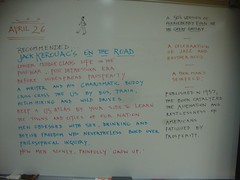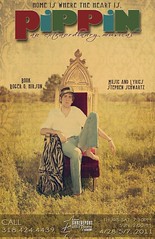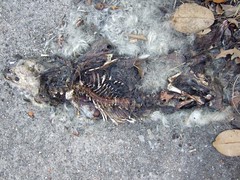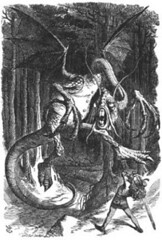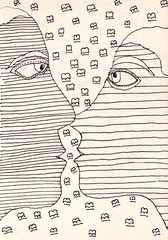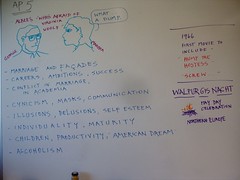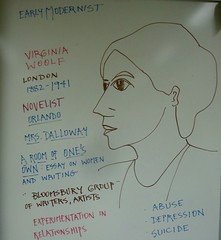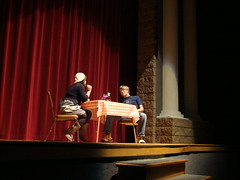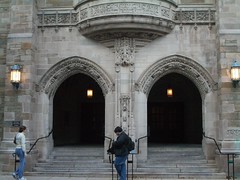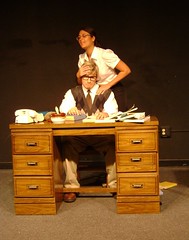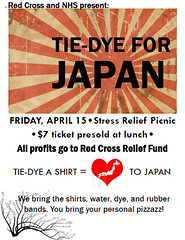Howl
by Allen Ginsberg
For Carl Solomon
I saw the best minds of my generation destroyed by madness, starving
hysterical naked,
dragging themselves through the negro streets at dawn looking for an angry
fix,
angelheaded hipsters burning for the ancient heavenly connection to the
starry dynamo in the machinery of night,
who poverty and tatters and hollow-eyed and high sat up smoking in the
supernatural darkness of cold-water flats floating across the tops of
cities contemplating jazz,
who bared their brains to Heaven under the El and saw Mohammedan angels
staggering on tenement roofs illuminated,
who passed through universities with radiant cool eyes hallucinating Arkan-
sas and Blake-light tragedy among the scholars of war,
who were expelled from the academies for crazy & publishing obscene odes
on the windows of the skull,
Thursday, April 28, 2011
On The Road and the Beat writers quiz
Fine arts in the 50's and 60's
For your answers, choose between (last names only) Allen Ginsberg William S Burroughs Jack Kerouac Tom Wolfe Lewis Carroll Edward Lear Edward Albee Bob Dylan Beatles.
1. On the Road, the picaresque novel published in 1957.
2. Howl, the long poem which was censored by an obscenity trial in San Francisco.
3. "The Scroobious Pip," a nonsense piece that influenced 60's writers.
4. The vile quasi-novel, Naked Lunch. Was banned in Boston as obscene.
5. The satiric drama Who's Afraid of Virginia Woolf.
6. Though adopted, was raised by a wealthy family in Manhattan.
7. Became a student at Columbia University through a football scholarship.
8. Alice's Adventures in Wonderland.
9. The author of "Jabberwocky."
10. "Blowin' in the Wind" and "The Times They Are a-Changin'"
11. Marriage and alcoholism.
12. Writing similar to that of Mark Twain or F. Scott Fitzgerald.
13. Within you, without you," "She's leaving home."
14. The novel The Dharma Bums.
15. Spontaneous prose was part of his style.
16. Philosophical inquiry in the midst of the headlong pursuit of drugs, drink and sex.
17. The second city - after NYC - for many of the Beat writers: a) Chicago b) Houston c) New Orleans d) San Francisco.
For your answers, choose between (last names only) Allen Ginsberg William S Burroughs Jack Kerouac Tom Wolfe Lewis Carroll Edward Lear Edward Albee Bob Dylan Beatles.
1. On the Road, the picaresque novel published in 1957.
2. Howl, the long poem which was censored by an obscenity trial in San Francisco.
3. "The Scroobious Pip," a nonsense piece that influenced 60's writers.
4. The vile quasi-novel, Naked Lunch. Was banned in Boston as obscene.
5. The satiric drama Who's Afraid of Virginia Woolf.
6. Though adopted, was raised by a wealthy family in Manhattan.
7. Became a student at Columbia University through a football scholarship.
8. Alice's Adventures in Wonderland.
9. The author of "Jabberwocky."
10. "Blowin' in the Wind" and "The Times They Are a-Changin'"
11. Marriage and alcoholism.
12. Writing similar to that of Mark Twain or F. Scott Fitzgerald.
13. Within you, without you," "She's leaving home."
14. The novel The Dharma Bums.
15. Spontaneous prose was part of his style.
16. Philosophical inquiry in the midst of the headlong pursuit of drugs, drink and sex.
17. The second city - after NYC - for many of the Beat writers: a) Chicago b) Houston c) New Orleans d) San Francisco.
Magnet fine arts: the importance of Kerouac and On The Road
On the Road is a highly-recommended book for the college-bound student or the adventure-minded person.
- Lower middle class life in the post-war, post-depression era prior to widespread prosperity.
- A writer and his charismatic buddy criss-cross the US by bus, hitch-hiking, train and careening, high-speed driving.
- Find an atlas and keep it by your side as you read so that you can learn the towns and cities of the US.
- Men obsessed with drinking, sex, drugs and boyish freedom nonetheless bond with each other over philosophical inquiry.
- How men slowly and painfully mature.
- Strong parallels with Huckleberry Finn and The Great Gatsby.
- A celebration of jazz and of brotherhood.
- Published in 1957 the tale catalyzed the alienated and restless youths already disillusioned by the material prosperity delivered by success in the American Dream.
1.Kerouac 2.Ginsberg 3.Lear 4.Burroughs 5.Albee 6.Albee 7.Kerouac 8.Carroll 9.Carroll
10.Dylan 11.Albee 12.Kerouac 13.Beatles 14.Kerouac 15.Kerouac 16.Kerouac 17.San Francisco.
- Lower middle class life in the post-war, post-depression era prior to widespread prosperity.
- A writer and his charismatic buddy criss-cross the US by bus, hitch-hiking, train and careening, high-speed driving.
- Find an atlas and keep it by your side as you read so that you can learn the towns and cities of the US.
- Men obsessed with drinking, sex, drugs and boyish freedom nonetheless bond with each other over philosophical inquiry.
- How men slowly and painfully mature.
- Strong parallels with Huckleberry Finn and The Great Gatsby.
- A celebration of jazz and of brotherhood.
- Published in 1957 the tale catalyzed the alienated and restless youths already disillusioned by the material prosperity delivered by success in the American Dream.
1.Kerouac 2.Ginsberg 3.Lear 4.Burroughs 5.Albee 6.Albee 7.Kerouac 8.Carroll 9.Carroll
10.Dylan 11.Albee 12.Kerouac 13.Beatles 14.Kerouac 15.Kerouac 16.Kerouac 17.San Francisco.
Saturday, April 23, 2011
Pippin / SLTA / Ap 28 - May 8
The play begins, says Wikipedia, with a Leading Player of a troupe and the accompanying actors in various costume pieces of several different time periods, establishing the play's intentionally anachronistic, defamiliarized, unconventional feel.
The Leading Player invites the audience to join them in a story about a boy prince searching for fulfillment ("Magic to Do"). They reveal that the boy who is to play the title character is a new actor.
The Leading Player invites the audience to join them in a story about a boy prince searching for fulfillment ("Magic to Do"). They reveal that the boy who is to play the title character is a new actor.
Thursday, April 21, 2011
Romantic poetry and prose, inspiring a jillion journeys: the Jack Kerouac novel On the Road
Kerouac wrote the novel On the Road in three weeks, typing continuously onto a 120-foot roll of teletype paper, he told many interviewers.[3]
However, although the story is true per se, the book was in fact the result of a long and arduous creative process, says Wikipedia.
Kerouac carried small notebooks in which much of the text was written as the eventful span of road trips unfurled. He started working on the first of several versions of the novel as early as 1948, based on experiences during his first long road trip in 1947. However, he remained unsatisfied with the novel.[4]
Inspired by a thousand-word rambling letter from his friend Neal Cassady, Kerouac in 1950 outlined the "Essentials of Spontaneous Prose" and decided to tell the story of his years on the road with Cassady as if writing a letter to a friend in a form that reflected the improvisational fluidity of jazz.[5]
It is a largely autobiographical work that was based on the spontaneous road trips of Kerouac and his friends. It is considered a defining work of the postwar Beat Generation.
Filmmakers (Gus Van Sant, Oliver Stone, etc etc), novelists (Ken Kesey, Tom Wolfe, etc), songwriters (Bob Dylan, Hendrix, etc) and other artists have, since the 1960's, considered On The Road a biblical text.
However, although the story is true per se, the book was in fact the result of a long and arduous creative process, says Wikipedia.
Kerouac carried small notebooks in which much of the text was written as the eventful span of road trips unfurled. He started working on the first of several versions of the novel as early as 1948, based on experiences during his first long road trip in 1947. However, he remained unsatisfied with the novel.[4]
Inspired by a thousand-word rambling letter from his friend Neal Cassady, Kerouac in 1950 outlined the "Essentials of Spontaneous Prose" and decided to tell the story of his years on the road with Cassady as if writing a letter to a friend in a form that reflected the improvisational fluidity of jazz.[5]
It is a largely autobiographical work that was based on the spontaneous road trips of Kerouac and his friends. It is considered a defining work of the postwar Beat Generation.
Filmmakers (Gus Van Sant, Oliver Stone, etc etc), novelists (Ken Kesey, Tom Wolfe, etc), songwriters (Bob Dylan, Hendrix, etc) and other artists have, since the 1960's, considered On The Road a biblical text.
Wednesday, April 20, 2011
Magnet fine arts: Carroll & Lear
Lewis Carroll (1832 - 1898), was the pseudonym for Charles Dodgson, author, mathematician, clergyman and photographer.
- Alice's Adventures in Wonderland
- Through the Looking Glass
- Jabberwocky"
- "The Hunting of the Snark"
Influenced Lennon, McCartney and other authors, illustrators and filmmakers.
Edward Lear (1812 - 1888) was an illustrator, artist (see his painting of Masada in the desert near the Dead Sea) and author of limericks and work such as "The Scroobious Pip."
- Alice's Adventures in Wonderland
- Through the Looking Glass
- Jabberwocky"
- "The Hunting of the Snark"
Influenced Lennon, McCartney and other authors, illustrators and filmmakers.
Edward Lear (1812 - 1888) was an illustrator, artist (see his painting of Masada in the desert near the Dead Sea) and author of limericks and work such as "The Scroobious Pip."
English Lit that influenced the artists and writers of the 60's: Lewis Carroll's "Jabberwocky"
`Twas brillig, and the slithy toves
Did gyre and gimble in the wabe:
All mimsy were the borogoves,
And the mome raths outgrabe.
"Beware the Jabberwock, my son!
The jaws that bite, the claws that catch!
Beware the Jubjub bird, and shun
The frumious Bandersnatch!"
He took his vorpal sword in hand:
Long time the manxome foe he sought --
So rested he by the Tumtum tree,
And stood awhile in thought.
And, as in uffish thought he stood,
The Jabberwock, with eyes of flame,
Came whiffling through the tulgey wood,
And burbled as it came!
One, two! One, two! And through and through
The vorpal blade went snicker-snack!
He left it dead, and with its head
He went galumphing back.
"And, has thou slain the Jabberwock?
Come to my arms, my beamish boy!
O frabjous day! Callooh! Callay!"
He chortled in his joy.
`Twas brillig, and the slithy toves
Did gyre and gimble in the wabe;
All mimsy were the borogoves,
And the mome raths outgrabe.
Did gyre and gimble in the wabe:
All mimsy were the borogoves,
And the mome raths outgrabe.
"Beware the Jabberwock, my son!
The jaws that bite, the claws that catch!
Beware the Jubjub bird, and shun
The frumious Bandersnatch!"
He took his vorpal sword in hand:
Long time the manxome foe he sought --
So rested he by the Tumtum tree,
And stood awhile in thought.
And, as in uffish thought he stood,
The Jabberwock, with eyes of flame,
Came whiffling through the tulgey wood,
And burbled as it came!
One, two! One, two! And through and through
The vorpal blade went snicker-snack!
He left it dead, and with its head
He went galumphing back.
"And, has thou slain the Jabberwock?
Come to my arms, my beamish boy!
O frabjous day! Callooh! Callay!"
He chortled in his joy.
`Twas brillig, and the slithy toves
Did gyre and gimble in the wabe;
All mimsy were the borogoves,
And the mome raths outgrabe.
Sunday, April 17, 2011
Who's Afraid of Virginia Woolf quiz
Who's Afraid of Virginia Woolf quiz
Name the speaker for quotes 1 - 13.
1. "Will you show her where we keep the, uh, euphemism?"
2. "In my mind, you are buried in cement right up to the neck. No, up
to the nose — it's much quieter."
3."I hope that was an empty bottle! You can't afford to waste good liquor."
4. "Never mix, never worry!"
5. "Unless you're carrying on like a hyena, you're not having any fun."
6. "Don't worry about it! Anybody who comes here ends up getting
testy; it's expected! Don't be upset!"
7. "They're dancing like they (have) danced before."
8. "There was a second back there — yeah, there was a second, just a
second — when I could have gotten through to you, when maybe we could
have cut through all this, this CRAP! But it's past, and I'm not gonna
try."
9. "To you, everybody's a flop!"
10. "I disgust me."
11. "Someone who can keep learning the games we play as quickly as I
can change them."
12. "Truth or illusion; you don't know the difference."
13. "A drowning man takes down those nearest."
14. Northeast state in which the WAVW college is located. __
15. Welsh actor who won fame playing King Arthur in the musical
"Camelot." Also appeared in the movie "Cleopatra." __ __
16. One exploration of WAVW is that of the facade of married couples.
What's the name for the diacritical mark that makes the hard C sound
into an S sound? ___
17. In 1966-67 WAVW won the Pulitzer Prize for literature. T / F
18. US president who was in office when the play of WAVW debuted (1962). ____
19. English author, essayist, publisher, and writer of short stories, regarded as one of the foremost modernist literary figures of the
twentieth century.
20. Word that begins with "n" that means "ready or suitable for marriage by virtue of age or maturity."
"Euphemism" means a nice word for an item that is in some way taboo:
"Pardon me while I powder my nose" means "I'm going to the toilet."
"She's visually impaired." "She's blind."
"Please don't be a freaking idiot." "You're a f***ing idiot."
Name the speaker for quotes 1 - 13.
1. "Will you show her where we keep the, uh, euphemism?"
2. "In my mind, you are buried in cement right up to the neck. No, up
to the nose — it's much quieter."
3."I hope that was an empty bottle! You can't afford to waste good liquor."
4. "Never mix, never worry!"
5. "Unless you're carrying on like a hyena, you're not having any fun."
6. "Don't worry about it! Anybody who comes here ends up getting
testy; it's expected! Don't be upset!"
7. "They're dancing like they (have) danced before."
8. "There was a second back there — yeah, there was a second, just a
second — when I could have gotten through to you, when maybe we could
have cut through all this, this CRAP! But it's past, and I'm not gonna
try."
9. "To you, everybody's a flop!"
10. "I disgust me."
11. "Someone who can keep learning the games we play as quickly as I
can change them."
12. "Truth or illusion; you don't know the difference."
13. "A drowning man takes down those nearest."
14. Northeast state in which the WAVW college is located. __
15. Welsh actor who won fame playing King Arthur in the musical
"Camelot." Also appeared in the movie "Cleopatra." __ __
16. One exploration of WAVW is that of the facade of married couples.
What's the name for the diacritical mark that makes the hard C sound
into an S sound? ___
17. In 1966-67 WAVW won the Pulitzer Prize for literature. T / F
18. US president who was in office when the play of WAVW debuted (1962). ____
19. English author, essayist, publisher, and writer of short stories, regarded as one of the foremost modernist literary figures of the
twentieth century.
20. Word that begins with "n" that means "ready or suitable for marriage by virtue of age or maturity."
"Euphemism" means a nice word for an item that is in some way taboo:
"Pardon me while I powder my nose" means "I'm going to the toilet."
"She's visually impaired." "She's blind."
"Please don't be a freaking idiot." "You're a f***ing idiot."
Thursday, April 14, 2011
The 60's paper: 3 sources on one artist and one of their most famous works
When I present Jimi Hendrix in the fine arts context I show how he transformed blues music from the black musicians of America into psychedelic soundscapes, an international explosion that he managed via special FX and a blessed sense of imagination.
Showing how he used the city of London and British musical energy to leap to success, I focus on his classic version of "The Star Spangled Banner," (as performed at Woodstock Festival, 1969). This simple but brilliant work galvanized the world.
Showing how he used the city of London and British musical energy to leap to success, I focus on his classic version of "The Star Spangled Banner," (as performed at Woodstock Festival, 1969). This simple but brilliant work galvanized the world.
Albee sees what's rotten underneath the bright fruit of the American Dream
- Marriage and the facades thereupon (see the cedilla in the word facade, please).
- Ambitions, proper careers, the definitions of success.
- Masks, cynicism, the inability to communicate despite being close.
- Delusions of American society.
- Individuality and independence.
- The American Dream of the college degree, well-paid job, suburban house, 2.5 children, nice cars, summer house, etc etc.
- Alcoholism, then a dirty little secret of middle class life in the US.
- Ambitions, proper careers, the definitions of success.
- Masks, cynicism, the inability to communicate despite being close.
- Delusions of American society.
- Individuality and independence.
- The American Dream of the college degree, well-paid job, suburban house, 2.5 children, nice cars, summer house, etc etc.
- Alcoholism, then a dirty little secret of middle class life in the US.
WAVW: who was Virginia Woolf, anyway?
Virginia Woolf is arguably the major lyrical novelist in the English language, says Wikipedia.
Her novels are highly experimental: a narrative, frequently uneventful and commonplace, is refracted—and sometimes almost dissolved—in the characters' receptive consciousness. Intense lyricism and stylistic virtuosity fuse to create a world overabundant with auditory and visual impressions.[18]
Her most famous works include the novels Mrs Dalloway (1925), To the Lighthouse (1927) and Orlando (1928), and the book-length essay A Room of One's Own (1929), with its famous dictum, "A woman must have money and a room of her own if she is to write fiction."
After completing her last (posthumously published) novel, Between the Acts, Woolf fell into a depression similar to that which she had earlier experienced. The onset of World War II, the destruction of her London home during the Blitz, and the cool reception given to her biography of her late friend Roger Fry all worsened her condition until she was unable to work.[12] On 28 March 1941, Woolf put on her overcoat, filled its pockets with stones, and walked into the River Ouse near her home and drowned.
Her novels are highly experimental: a narrative, frequently uneventful and commonplace, is refracted—and sometimes almost dissolved—in the characters' receptive consciousness. Intense lyricism and stylistic virtuosity fuse to create a world overabundant with auditory and visual impressions.[18]
Her most famous works include the novels Mrs Dalloway (1925), To the Lighthouse (1927) and Orlando (1928), and the book-length essay A Room of One's Own (1929), with its famous dictum, "A woman must have money and a room of her own if she is to write fiction."
After completing her last (posthumously published) novel, Between the Acts, Woolf fell into a depression similar to that which she had earlier experienced. The onset of World War II, the destruction of her London home during the Blitz, and the cool reception given to her biography of her late friend Roger Fry all worsened her condition until she was unable to work.[12] On 28 March 1941, Woolf put on her overcoat, filled its pockets with stones, and walked into the River Ouse near her home and drowned.
What was on Edward Albee's mind as he wrote Who's Afraid of Virginia Woolf: Allen Ginsberg, Bob Dylan and the revolutionary artists of the 60's
The 60's revolution in the fine arts began in the late 1950's with the Beat ("beatnik") writers, among them Allen Ginsberg, Jack Kerouac and William S Burroughs.
The American singer-songwriter and poet Bob Dylan, inspired by and lending inspiration to these writers, had an even greater impact on pop culture and the fine arts. His early 60's songs such as "Blowin' in the Wind" and "The Times They Are a-Changin'" became anthems for the US civil rights[3] and anti-war[4] movements.
Dylan revolutionized perceptions of the limits of popular music in 1965 with the six-minute single "Like a Rolling Stone."
Kerouac wrote On The Road (1957), a romance about dropping out of college, hitchhiking and trying to become a poet and philosopher. Wikipedia says it defined "the postwar Beat Generation that was inspired by jazz, poetry, and drug experiences."
William S Burroughs wrote numerous trippy and disturbingly sex-and-drug-oriented novels, the most famous of which is the 1959 non-linear work Naked Lunch. Says Wikipedia, "The novel's mix of taboo fantasies,peculiar creatures (like the predatory Mugwumps), and eccentric personalities all serve to unmask mechanisms and processes of control, and have led to much controversy."
Ginsberg became the most famous poet of America when his long poem, Howl, was judged obscene by the San Francisco
district attorney. The poem went to court because of its colloquial references to sexual acts. The ensuing publicity put Ginsberg and his poetry on the world map.
I recommend the recent James DeFranco movie Howl, which is a recitation of the poem and a re-telling of the court case.
Both Howl and Naked Lunch were the focus of obscenity trials that ultimately helped to liberalize what could be published in the United States.
The writers and singers of the Beat Generation became the world's new bohemian hedonists. The French and Germans had been the masters of hip art prior to this. They celebrated non-conformity and spontaneous creativity.
The original "Beat Generation" writers met in New York. Many found themselves in San Francisco in the mid-1950s. They drove and hitch-hiked cross country through the 50's and 60's. By the mid 60
s the Beat Generation gave way to the Sixties Counterculture, which was accompanied by a shift in public terminology from "beatnik" to "hippie."
The American singer-songwriter and poet Bob Dylan, inspired by and lending inspiration to these writers, had an even greater impact on pop culture and the fine arts. His early 60's songs such as "Blowin' in the Wind" and "The Times They Are a-Changin'" became anthems for the US civil rights[3] and anti-war[4] movements.
Dylan revolutionized perceptions of the limits of popular music in 1965 with the six-minute single "Like a Rolling Stone."
Kerouac wrote On The Road (1957), a romance about dropping out of college, hitchhiking and trying to become a poet and philosopher. Wikipedia says it defined "the postwar Beat Generation that was inspired by jazz, poetry, and drug experiences."
William S Burroughs wrote numerous trippy and disturbingly sex-and-drug-oriented novels, the most famous of which is the 1959 non-linear work Naked Lunch. Says Wikipedia, "The novel's mix of taboo fantasies,peculiar creatures (like the predatory Mugwumps), and eccentric personalities all serve to unmask mechanisms and processes of control, and have led to much controversy."
Ginsberg became the most famous poet of America when his long poem, Howl, was judged obscene by the San Francisco
district attorney. The poem went to court because of its colloquial references to sexual acts. The ensuing publicity put Ginsberg and his poetry on the world map.
I recommend the recent James DeFranco movie Howl, which is a recitation of the poem and a re-telling of the court case.
Both Howl and Naked Lunch were the focus of obscenity trials that ultimately helped to liberalize what could be published in the United States.
The writers and singers of the Beat Generation became the world's new bohemian hedonists. The French and Germans had been the masters of hip art prior to this. They celebrated non-conformity and spontaneous creativity.
The original "Beat Generation" writers met in New York. Many found themselves in San Francisco in the mid-1950s. They drove and hitch-hiked cross country through the 50's and 60's. By the mid 60
s the Beat Generation gave way to the Sixties Counterculture, which was accompanied by a shift in public terminology from "beatnik" to "hippie."
Tuesday, April 12, 2011
Who's Afraid of Virginia Woolf: research and analysis
Writing a brief paper of explanation following your consumption of a well-known work is a standard expectation of the academic world.
On literary sources such as Shakespeare, Mario Livio, Stephen King or even Muhammad Ali, there are sites offering key quotes from their most famous works.
And there are sites that give you an academic, expert analysis of the plot and meaning.
In this brief paper, choose
- at least 3 quotes from the movie
- at least 3 passages of analysis from at least 2 sites.
- cite your sources informally by adding "according to " and a source for the 3 required citations.
Assemble your analysis paper - the why and wherefore of Virginia Woolf - by blending these elements.
12 pts.
Wikipedia is OK for me!
WAVW quiz: 1.G 2.G 3.M 4.H 5.G 6.G 7.H 8.M 9.N 10.M 11.M 12.M 13.M 14.Conn 15.Richard Burton 16.cedilla 17.False 18.JFK 19.Virginia Woolf 20.nubile
On literary sources such as Shakespeare, Mario Livio, Stephen King or even Muhammad Ali, there are sites offering key quotes from their most famous works.
And there are sites that give you an academic, expert analysis of the plot and meaning.
In this brief paper, choose
- at least 3 quotes from the movie
- at least 3 passages of analysis from at least 2 sites.
- cite your sources informally by adding "according to " and a source for the 3 required citations.
Assemble your analysis paper - the why and wherefore of Virginia Woolf - by blending these elements.
12 pts.
Wikipedia is OK for me!
WAVW quiz: 1.G 2.G 3.M 4.H 5.G 6.G 7.H 8.M 9.N 10.M 11.M 12.M 13.M 14.Conn 15.Richard Burton 16.cedilla 17.False 18.JFK 19.Virginia Woolf 20.nubile
Friday, April 8, 2011
Connecticut: affluent, well-educated, historic
With the setting of Who's Afraid of Virginia Woolf in a fictitious college in Conn, we note the importance of the state.
- Long Island Sound; the coastline offers access to the world and is close to NYC.
- Hartford - center of the US insurance industry.
- New Haven - home of Yale Univ.
- Bridgeport - historic manufacturing center.
- Saybrook - historic port.
- Mystic - historic port tourism center.
- Stonington - historic port.
- Stamford - one of many affluent suburban centers adjacent to NYC.
- Connecticut River valley - rich farmland.
Yale will be symbolic of an array of colleges, such as U Conn, and private schools (The Hotchkiss School).
Mark Twain's A Connecticut Yankee in King Arthur's Court is symbolic of Conn's place in US lit.
Nearby
- Massachustts is also affluent and influential in arts and science.
- Boston, home of Harvard & MIT.
- Cape Cod - historic peninsula.
- Martha's Vineyard and Nantucket, islands that are summer enclaves of the wealthy.
- Rhode Island - small but affluent.
- Providence - capital and home to Brown Univ and Rhode Is School of Design (RISD).
- Long Island Sound; the coastline offers access to the world and is close to NYC.
- Hartford - center of the US insurance industry.
- New Haven - home of Yale Univ.
- Bridgeport - historic manufacturing center.
- Saybrook - historic port.
- Mystic - historic port tourism center.
- Stonington - historic port.
- Stamford - one of many affluent suburban centers adjacent to NYC.
- Connecticut River valley - rich farmland.
Yale will be symbolic of an array of colleges, such as U Conn, and private schools (The Hotchkiss School).
Mark Twain's A Connecticut Yankee in King Arthur's Court is symbolic of Conn's place in US lit.
Nearby
- Massachustts is also affluent and influential in arts and science.
- Boston, home of Harvard & MIT.
- Cape Cod - historic peninsula.
- Martha's Vineyard and Nantucket, islands that are summer enclaves of the wealthy.
- Rhode Island - small but affluent.
- Providence - capital and home to Brown Univ and Rhode Is School of Design (RISD).
Monday, April 4, 2011
Who's afraid of Virginia Woolf? the Welsh actor Richard Burton
Richard Burton, CBE ( 1925 – 1984) was a British 7 time Academy Award nominated, Golden Globe Award winning actor. He was at one time the highest-paid actor in Hollywood and is best associated with his second wife, actress Elizabeth Taylor, notes Wikipedia. [1]
Early on as an actor, he developed the habit of toting around a book-bag filled with novels, dictionaries, a complete Shakespeare, and books of quotations, history, and biography, to stoke his mind and stimulate conversation. He was also an enthusiastic crossword puzzle solver. His Welsh love of language was paramount, as he famously stated years later, with a tearful Elizabeth Taylor at his side, “The only thing in life is language. Not love. Not anything else.”[18]
Burton appeared on Broadway, receiving a Tony Award nomination for Time Remembered (1958) and winning the award for playing King Arthur in the musical Camelot (1960). Burton's reviews were excellent, Time magazine stated that Burton “gives Arthur the skillful and vastly appealing performance that might be expected from one of England's finest young actors”. The show's album was a major seller. The Kennedys, newly in the White House, also enjoyed the play and invited Burton for a visit, establishing the link of the idealistic, young Kennedy administration with Camelot.
In the troubled production Cleopatra (1963), Twentieth Century-Fox's future appeared to hinge on what became the most expensive movie ever made up until then, reaching almost $40 million.[43] The film proved to be the start of Burton's most successful period in Hollywood; he would remain among the top 10 box-office earners for the next four years. During the filming, Burton met and fell in love with Elizabeth Taylor, who was married to Eddie Fisher.
He and Taylor had a great success in Mike Nichols's film (1966) of the Edward Albee play Who's Afraid of Virginia Woolf?, in which a bitter erudite couple spend the evening trading vicious barbs in front of their horrified and fascinated guests, played by George Segal and Sandy Dennis.
Burton died of a cerebral hemorrhage in 1984 at his home in Switzerland, where he is buried. He was 58 years old.
Early on as an actor, he developed the habit of toting around a book-bag filled with novels, dictionaries, a complete Shakespeare, and books of quotations, history, and biography, to stoke his mind and stimulate conversation. He was also an enthusiastic crossword puzzle solver. His Welsh love of language was paramount, as he famously stated years later, with a tearful Elizabeth Taylor at his side, “The only thing in life is language. Not love. Not anything else.”[18]
Burton appeared on Broadway, receiving a Tony Award nomination for Time Remembered (1958) and winning the award for playing King Arthur in the musical Camelot (1960). Burton's reviews were excellent, Time magazine stated that Burton “gives Arthur the skillful and vastly appealing performance that might be expected from one of England's finest young actors”. The show's album was a major seller. The Kennedys, newly in the White House, also enjoyed the play and invited Burton for a visit, establishing the link of the idealistic, young Kennedy administration with Camelot.
In the troubled production Cleopatra (1963), Twentieth Century-Fox's future appeared to hinge on what became the most expensive movie ever made up until then, reaching almost $40 million.[43] The film proved to be the start of Burton's most successful period in Hollywood; he would remain among the top 10 box-office earners for the next four years. During the filming, Burton met and fell in love with Elizabeth Taylor, who was married to Eddie Fisher.
He and Taylor had a great success in Mike Nichols's film (1966) of the Edward Albee play Who's Afraid of Virginia Woolf?, in which a bitter erudite couple spend the evening trading vicious barbs in front of their horrified and fascinated guests, played by George Segal and Sandy Dennis.
Burton died of a cerebral hemorrhage in 1984 at his home in Switzerland, where he is buried. He was 58 years old.
Who's Afraid of Virginia Woolf notes
- cedilla: diacritical mark under the letter C in words such as facade.
- erudite - learned.
- randy - hormonally charged; desirous.
- nubile - young and appealing; marriageable.
1962 - JFK and glamorous wife, Jackie, preside over an administration called "Camelot," The play "Camelot" was about King Arthur and his knights, of course. Kennedy was charismatic and seemed royal.
The play "Who's Afraid of Virginia Woolf" was seen as quite daring and edgy. It was denied a Pulitzer prize for its language and treatment of marriage.
- 1966 - Elizabeth Taylor and Richard Burton starred in the movie version. It won 13 nominations for Academy Awards.
- Edward Albee: greatest living American playwright. Numerous awards and world-wide acclaim. His plays are studied in literature, drama and fine arts classes in virtually all high schools and colleges.
- erudite - learned.
- randy - hormonally charged; desirous.
- nubile - young and appealing; marriageable.
1962 - JFK and glamorous wife, Jackie, preside over an administration called "Camelot," The play "Camelot" was about King Arthur and his knights, of course. Kennedy was charismatic and seemed royal.
The play "Who's Afraid of Virginia Woolf" was seen as quite daring and edgy. It was denied a Pulitzer prize for its language and treatment of marriage.
- 1966 - Elizabeth Taylor and Richard Burton starred in the movie version. It won 13 nominations for Academy Awards.
- Edward Albee: greatest living American playwright. Numerous awards and world-wide acclaim. His plays are studied in literature, drama and fine arts classes in virtually all high schools and colleges.
Subscribe to:
Posts (Atom)


